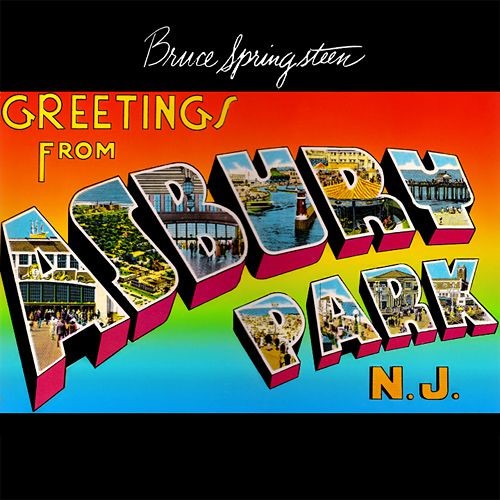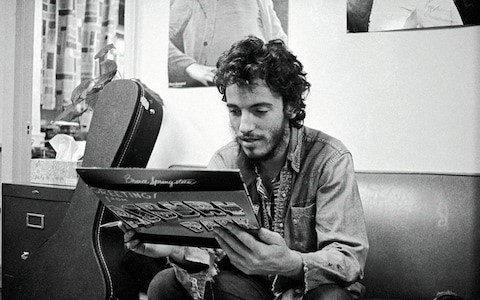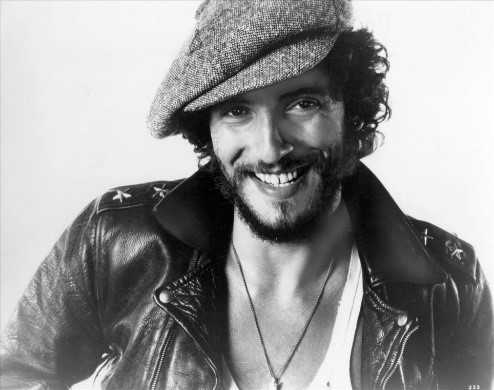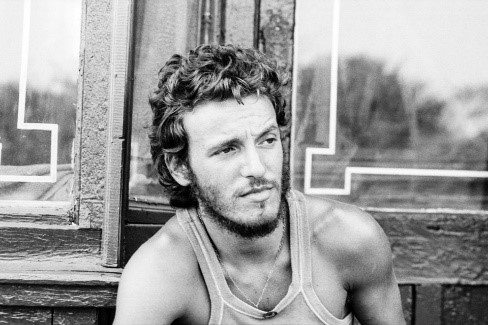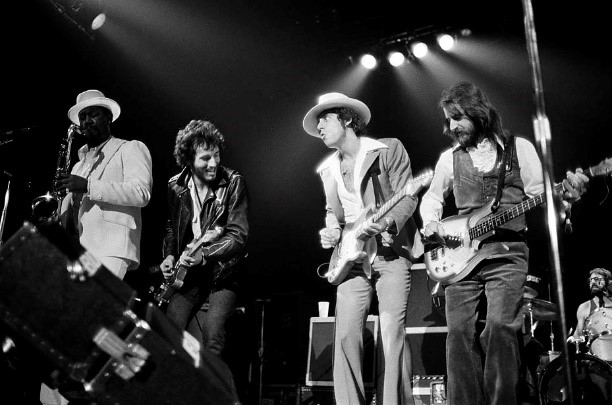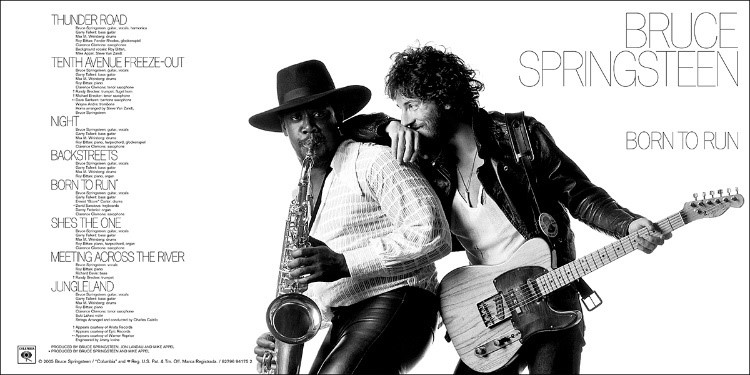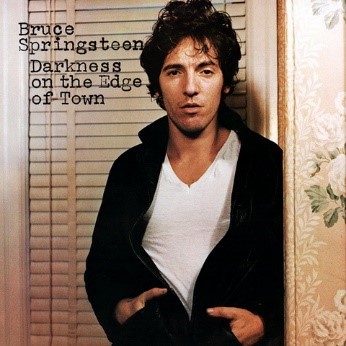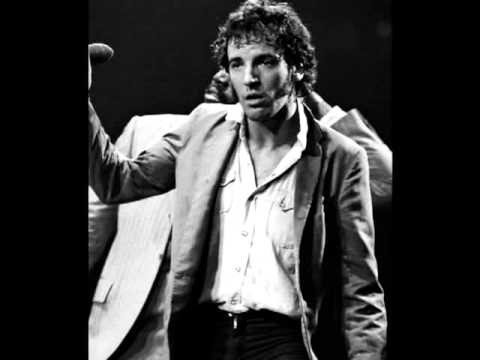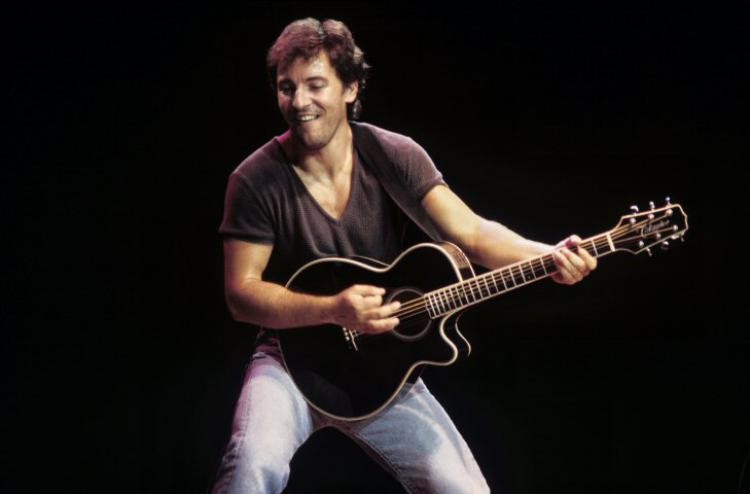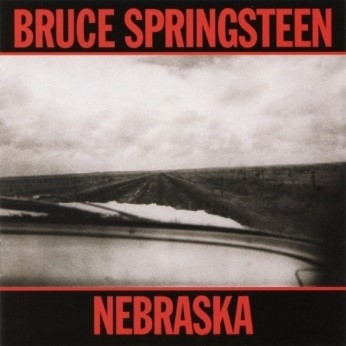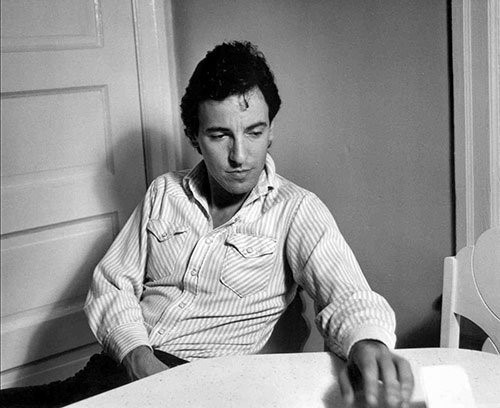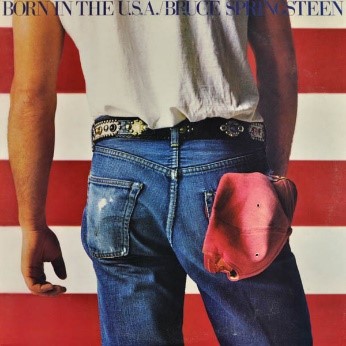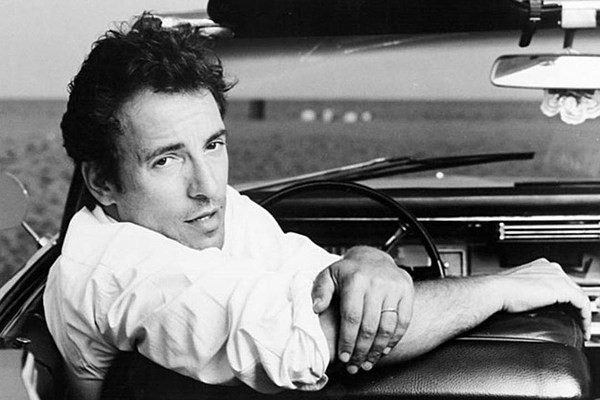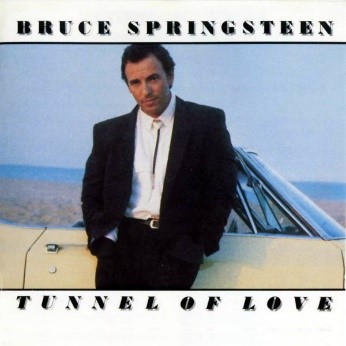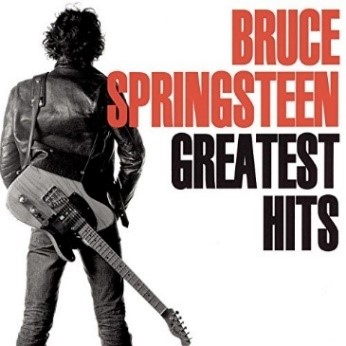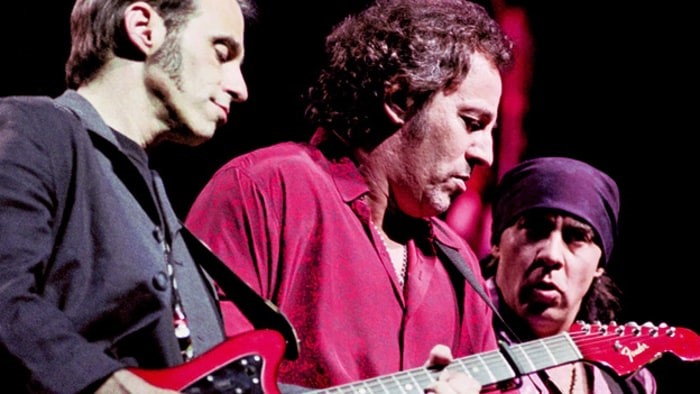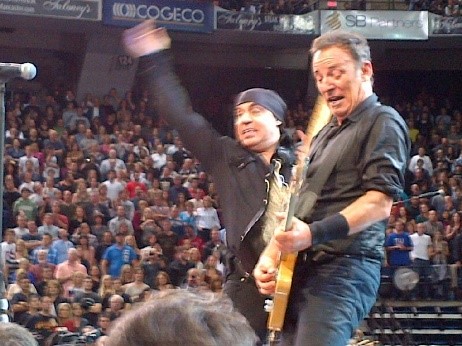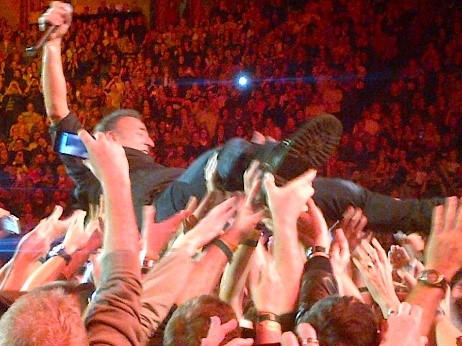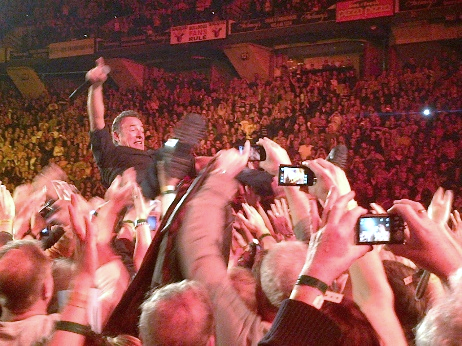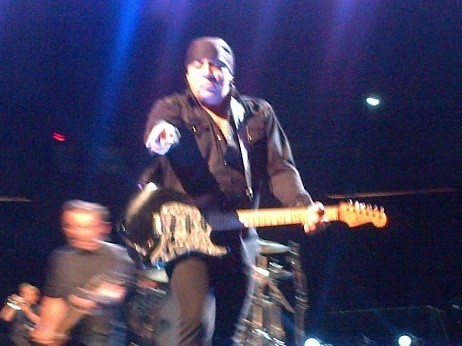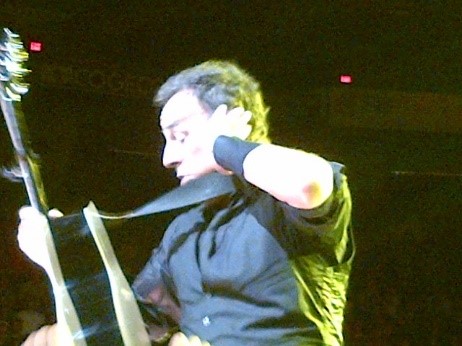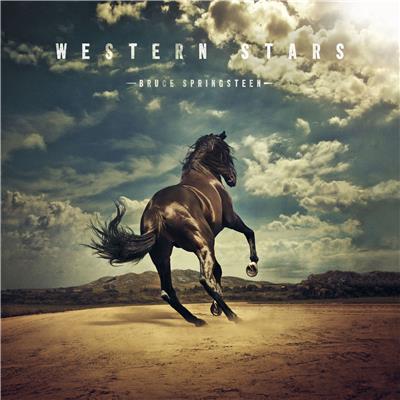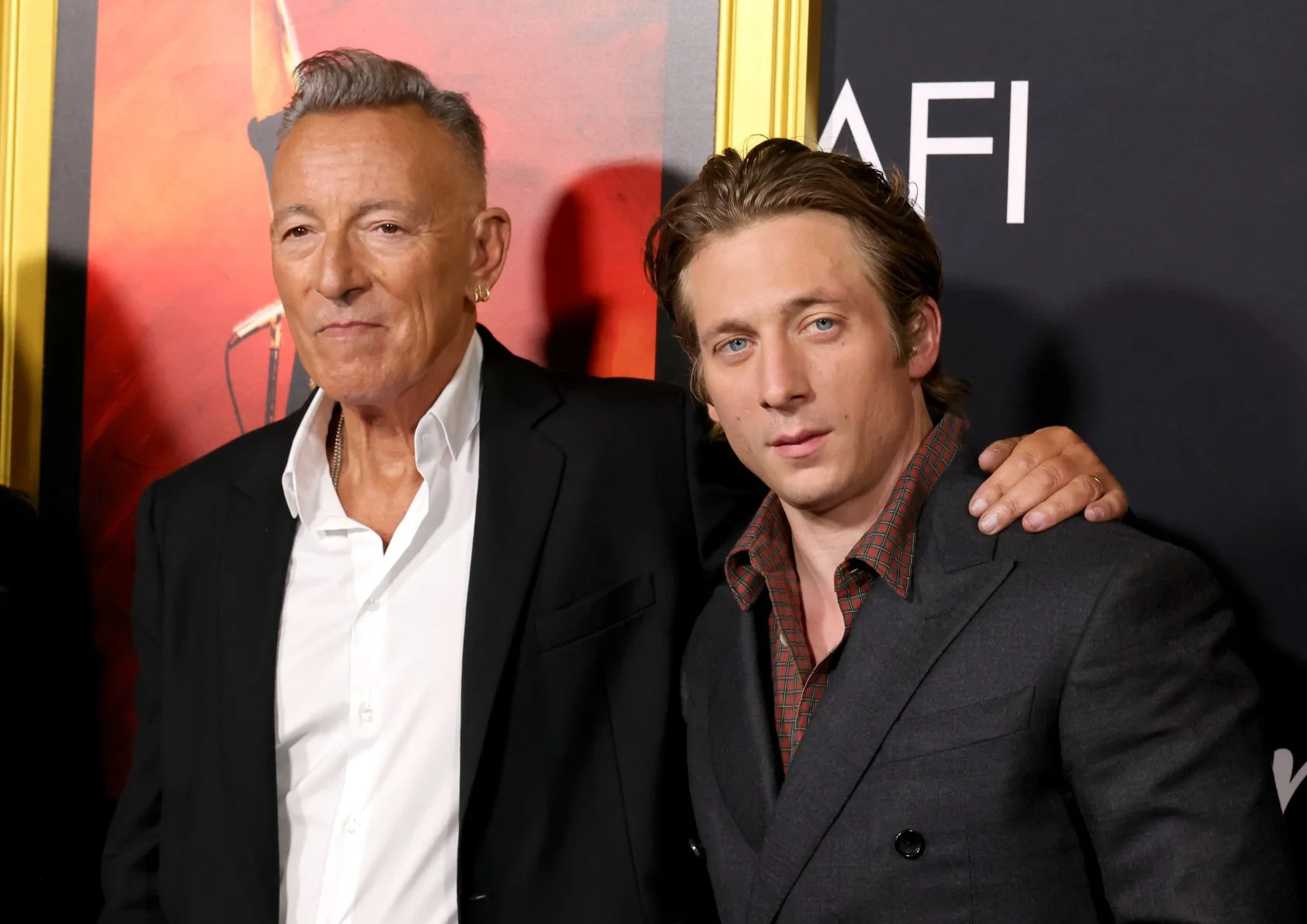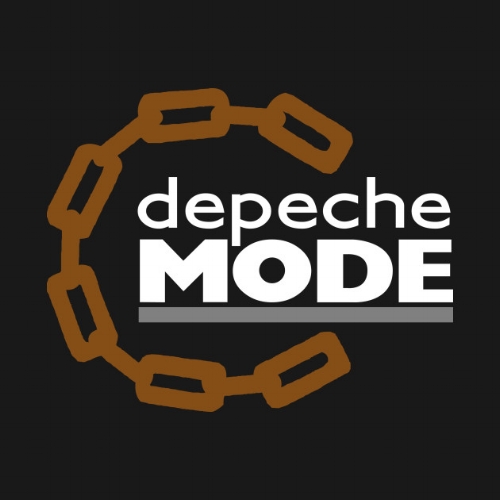The Wild, The Innocent, & The E Street Shuffle: A Bruce Springsteen Deep Dive Retrospective
Click on the streaming service of your choice to listen to the playlist as you read along. Spotify is the album versions while YouTube includes several live performances.
In January 2018 I travelled to New York to see Bruce Springsteen’s one-man show on Broadway. There are very few artists I would go to such lengths to see, and as always, the venerable performer delivered. After that experience it was time to do a write-up on ‘The Boss,’ the living legend whose music I grew up with, whom I’ve now seen perform eleven times, and the only artist that competes with New Order for the claim as my favourite artist.
The Playlist
Does this Bus Stop at 82nd Street?
It's Hard to Be A Saint in the City
4th of July, Asbury Park (Sandy)
Kitty's Back
Night
Candy's Room
Streets of Fire
Jackson Cage
I Wanna Marry You
The Price You Pay
Johnny 99
I'm Goin' Down
Two Faces
I Wish I Were Blind
My Beautiful Reward
The Fuse
Long Time Comin'
You'll Be Comin' Down
Last to Die
This Life
This Depression
Heaven's Wall
Hurry Up Sundown
Sundown
I’ll See You in My Dreams
Springsteen has travelled through many stages in his career, seen the highs and the lows, and developed many die-hard fans, casual followers, and detractors large and small. Depending on your perspective he can be everything that is great about rock n’ roll or just another aging dinosaur rocker who should be sent out to pasture. I grew up listening to his music from when I was young since my brother played it all the time and talked about Bruce often. While I ignored most of the artists of that era in which my brother played, it was Springsteen that I latched onto. It is a testament to the music that it broke through and imprinted on me an appreciation for his music and vision. My fandom has waned at times over the years and there are good chunks of his discography I don’t care much for, but otherwise my deep appreciate has held for almost forty years.
Bruce Springsteen was born in 1949 in Freehold, New Jersey, a blue-collar town just in from the shore. Raised in an Irish-Catholic tradition, he watched his family struggle to make ends meet. Inspired by Elvis Presley, The Beatles, and the rise of rock n’ roll, he started playing the guitar and, after a false start or two, dedicated himself to a life of music. Amazingly, Springsteen has never held a job other than as a musician. It’s the only way he’s ever made a living, for better or worse. I find that fact rather amazing, especially when taking into account his parents moved to California when he was eighteen and he stayed in New Jersey, left to fend for himself.
His early career started after moving to Asbury Park and playing in bands, first The Castiles, then Steel Mill, and then eventually his own acts, Dr. Zoom and the Sonic Boom and then The Bruce Springsteen band. Travelling up and down the shore playing every bar along the way, he scraped enough money together to put food on the table, though sometimes had to sleep on the floor of a few places or on friend’s couches. As he entered his early twenties, he had established himself as a guitarist and singer of some repute in the Jersey shore scene, a notable performer of blues and rock offered up in a passionate display.
Bruce was also a forceful and committed leader, resulting in the nickname ‘The Boss,’ a moniker he has forever decried given his general disdain for authority. However, he knew he could only attain his musical vision by maintaining control over his songs and his career. It was a decision he made early and has held throughout his career.
In 1970, his band Steel Mill made a cross-country drive to California to play some shows. It exposed Bruce to the vastness and various conditions of the American people. The trip did not result in any increased attention for the music. Ironically, at the age of twenty-one, the trip was only when Bruce learned to drive, despite the future frequent focus of his lyrics on cars. Back in Jersey, by 1972 he was frustrated at not having been discovered despite knowing he was as good or better than those he was hearing on the radio. He decided the problem was no one was going to discover him on the Jersey shore. He had to get out while he was young.
“Does this Bus Stop at 82nd Street?”; “It’s Hard to Be A Saint in the City” \ Greetings from Asbury Park, NJ (1973)
Springsteen caught his break when he hooked up with Mike Appel as his manager. Appel finagled a meeting with John Hammond at Columbia Records in New York, famous for signing many great folk and blues artists including Bob Dylan. Bruce performed a few songs in Hammond’s office on his guitar, and the passion and lyrical depth of his songs excited the famous producer, who quickly got Bruce signed and into a studio to record his first album. Columbia thought they’d found the next Dylan, the next great folk-rock, poet-singer-songwriter. When Bruce showed up at the studio with a busload of musicians the label was taken aback – this was not what they had in mind.
It was a conundrum for the label and rock fans. Bruce was a solo artist with a big band sound, one of the first to pack rock songs with a multitude of instruments. Until then most rock bands were four or five players and focused on guitar, bass, and drums. Piano was assurgent with the likes of Elton John and Billy Joel but was added more because the artist themselves played it. Soul bands could be large because of the horns and backing singers, but again those elements were a main feature, not just part of the mix. When Springsteen arrived with multiple guitars, piano, organ, sax, bass and drums and which none were dominant, it was a new direction for rock music.
The first album, with the apt title and postcard album cover, came straight from the Jersey shore and its musical heritage of blues, soul, jazz and swing. Many bands on the shore revelled in the ‘Jersey Swing’ sound, loving to take their blues and soul arrangements into long, extended jams with the full complement of an aggressive and energetic band. Bruce surrounded himself with a wonderful array of talent, all culled from his bands over the past few years: David Sancious on piano and organ, Garry W. Tallent on bass, and Vini ‘Mad Dog’ Lopez on drums. And yes, we heard the first contributions from Clarence ‘The Big Man’ Clemons, who had moved in the same Asbury Park circles for awhile and was asked by Bruce to contribute to the songs “Blinded by the Light” and “Spirit in the Night.” In the fall of 1971, Clarence agreed to leave his band and join Bruce permanently, a serendipitous decision that would create a sonic partnership that would define their brand of rock n’ roll for the next forty years.
The first thing to note on this album were the lyrics. The songs were packed with hundreds of words… per song. Extended ballads of colourful characters and inventive language made the songs like novels, each story its own. If there was a reason alone to appreciate Springsteen, it was his incredible way with words and the ability to paint a visceral scene of American life and the human condition. Overt politics would come later, but for this first effort Bruce was trying to capture the sights, sounds, and people of the towns in which he grew up. The Dylan comparisons were understandable, but no one was capturing the perspective, struggle, lament, and small joys of the American small town like Springsteen. It was because of this that he has been celebrated as a national icon, a poet laureate of rock and roll.
The first two albums musically were unlike anything else in his career, yet elements of what was to come were present. “Mary Queen of Arkansas” and “The Angel” showed the Dylanesque folk singer, stripped down to a piano or guitar. “Blinded by the Light,” “For You,” and “Does this Bus Stop at 82nd Street?” showed the rocker with the full band sound.
“Growin’ Up” was the first of the autobiographical, introspective songs that would cement the bond with his fans, mixing the personal with the universal, and creating the framework for his on-stage stories about his childhood. “The flag of piracy flew from my mast, my sails were set wing to wing / I had a jukebox graduate for first mate, she couldn't sail but she sure could sing.” “I hid in the crowded wrath of the crowd, but when they said, ‘sit down,’ I stood up”. “Spirit in the Night” was similar, though less personal but as much about his life – hanging with friends at Greasy Lake (his characters were like a cast of some gangster film: Crazy Janey, Wild Billy, G-Man, Hazy Davy and Killer Joe) and making one’s way through adolescence – all wrapped around one of the jazziest, bluesiest, swingiest melodies you could ever come across.
And then there was “Lost in the Flood” and “It’s Hard to Be a Saint in the City,” two different songs but equally epic and emotionally draining in their scope. Anyone who didn’t see Born to Run coming did not listen to these songs. “Lost in the Flood” was simply breathtaking, full of lulls and crescendos, guitar solos, and a lyrical tableau both cryptic and vivid. This song alone puts Springsteen in the upper echelons of song writers. “It’s Hard to Be A Saint in the City” was a sprint, pacing through the challenges and fears of a young man from a small town trying to make his way in the big city. I used this song for a poetry assignment in grade eleven and was mesmerized by the lyrics, dense and descriptive, yet easy to digest and inviting for exploration: “The devil appeared like Jesus through the steam in the street / Showin' me a hand I knew even the cops couldn't beat / I felt his hot breath on my neck as I dove into the heat / It's so hard to be a saint when you're just a boy out on the street.” Add a jazzy piano/drums combo and the song announced Bruce as an important and exciting new presence in the rock world.
The album reached #60 in the US and #41 in the UK and was a critical success. There was still a way to go before Springsteen became a household name.
“4th of July, Asbury Park (Sandy)”; “Kitty’s Back” \ The Wild, the Innocent, and the E Street Shuffle (1973)
I will try to contain myself here, because this is my favourite Springsteen album and I believe one of the greatest rock albums ever recorded. If he had done two or three more albums in this style I would have been very happy. Alas, Bruce was on a mission and progress and change were the mantra.
Still rooted in the R&B and jazz sounds of his upbringing, the second album was released the same year as the first, giving release to all his pent-up expression after years on the road cultivating his craft. Touring the US to promote the first LP he had assembled a regular band around his studio musicians. He also added his old friend, Danny Federici, on keyboards and accordion to help out David Sancious, because Bruce was a rare artist to combine piano and organ in his songs. It was this same line-up he’d take into the studio for the next album, with an eye to explore the grander, more ambitious reaches of the band’s capabilities. And thank the music gods for that.
Opening with horn blasts followed by the swinging melody of “The E Street Shuffle,” the first side of the album immediately revealed a more sophisticated sound from Bruce. The song closed with a jazz-soul jam full of energy and the feel of a late night, urban club.
The next song was one of his most beautiful ballads, the tribute to the colourful scene on the Asbury Park boardwalk. “4th of July, Asbury Park (Sandy)” was a rare rock song led by an accordion, and was again a beautiful, rich song full of colourful characters and poetic phrases, painting the life of a struggling artist trying to find a girl: “And me I just got tired of hangin' in them dusty arcades bangin' them pleasure machines / Chasin' the factory girls underneath the boardwalk where they all promise to unsnap their jeans.” But life didn’t come without setbacks, “Sandy that waitress I was seeing lost her desire for me / I spoke with her last night, she said she won't set herself on fire for me anymore.” So what to do other than hit the road, always the view of Bruce’s protagonists, “Did you hear the cops finally busted Madame Marie for tellin' fortunes better than they do / For me this boardwalk life is through, babe / You ought to quit this scene too.” This was a reference to the infamous boardwalk fortune teller, Madame Marie.
Before side one concluded with the carnival atmosphere of “Wild Billy’s Circus Story,” Springsteen unleashed one of the most energetic, jazziest, and exhilarating songs of his career, the likes of which we would not hear from him again. “Kitty’s Back” was a blast-and-a-half, propelled throughout by the stellar drumming of ‘Mad Dog’ who rightly earned the nickname (apparently both on and off-stage). The finale was lifted by the distinctive, high-pitched wailing of Clarence on sax, as only the Big Man could do. Throughout the song the leads were handed between guitar, organ, bass, and drums like a jazz jam. The song was marked with a reckless abandon that would sadly be abandoned on future albums.
The E Street Band 1972 (L to R): Clarence Clemons, Bruce, David Sancious, Vini 'Mad Dog' Lopez, Danny Federici, Gary W. Tallent
Side two amazingly stepped it up from the great first side. Three songs, strung together, took the listener on a thrilling and winding musical journey. It started with the lovely, piano-infused “Incident on 57th Street,” where all the instruments of the band came together in a perfectly controlled infusion. These early albums from Bruce had many of the elements of what made so many rock songs in the 70s great, especially when heard from today’s perspective. The analog recording, the thick and resonant drums, deep and natural bass lines, and acoustic guitar touches gave the songs a layered, almost-live feel that begged to be heard on a quality sound system. Like jazz, every instrument was doing its own thing but worked together as a whole. They don’t make albums like this anymore; The Wild, The Innocent & the E Street Shuffle is excuse enough to revive vinyl.
Next up was, “Rosalita (Come Out Tonight),” soon a signature song of Bruce’s live shows that detailed his prophesy for stardom as he encouraged Rosalita to, “cut loose her mama’s reins,” and implored her daddy to let her go out with him since it was, “his last chance to get his daughter in a fine romance / Because the record company, Rosie, just gave me a big advance.” Amidst the pursuit of Rosalita is yet another rich cast of characters, as we’re told about ‘Little Dynamite’ and ‘Little Gun,’ ‘Jack the Rabbit’ and ‘Weak Kneed Willie,’ and ‘Sloppy Sue’ and ‘Big Bone Billy.’ They all made the song read like an adult, urbanized version of some psychedelic children’s story – Lewis Carroll comes to lower Manhattan. As Clarence punctuated the swing melody the song rose to a climax and then a twinkling organ denouement settled the song into the opening of the album’s closing track.
“New York City Serenade” could very well be my favourite Springsteen song, perhaps as much because it was so different from his others and countered everything most people would assume about The Boss’ music. It also clocked in as his longest album track at just shy of ten minutes. The opening strums of piano strings led to a classical, dramatic piano intro which then blended into the clear picks of an acoustic guitar and the percussive notes of a conga, picking up a laid back groove that oozed gritty, New York cool. (It has always intrigued me that typical fans of classic rock, as I’ve come across them, are generally a less sophisticated looking crowd of dishevelled jeans, plaid shirts, Greb Kodiak boots (harkening back to my childhood, here) and unkempt hair – yet listen to rock music routinely drawn from the most sophisticated forms: classical and jazz. You can’t judge a book by it’s cover I guess, which at this point certainly applied to the scruffy songwriter from the Jersey shore.) The rest of the song was carried on piano and strings, all courtesy of David Sancious in his last and most significant contribution to Bruce’s legacy. It was one of the most beautiful songs ever to grace the grooves of a rock record and concluded an album that should have cemented Bruce immediately as a legendary talent. Critics recognized this, but fans were still slow to catch on as the album sold about the same as the debut. I have seen Springsteen perform 126 different songs live in the shows I’ve attended but am yet to hear this song. Some day, some day…
“Night” \ Born to Run (1975)
Bruce and the band toured non-stop over the next three years, slowly building an audience. Amidst those tours Bruce holed up in a small cottage in Long Branch, New Jersey, steps from the beach, to write the next album, a project he aspired to be the greatest rock album ever recorded.
His lofty ambition led to a meticulous, arduous writing and recording process that took two years and forced several changes to his band. Lamentably, the first to go was ‘Mad Dog’ Lopez, whose drumming style was too free for the wall-of-sound production Bruce was seeking (and who was also causing more drama than Bruce was willing to tolerate). He was replaced by Ernest ‘Boom Boom’ Carter. It was after that change to the line-up that “Born to Run” was recorded, taking more than six months to complete. Carter left soon after along with Sancious to create, not surprisingly, a jazz fusion band. This led to the arrivals of ‘The Professor’ Roy Bittan on piano and ‘Mighty’ Max Weinberg on drums.
The line-up changes immediately altered the sound of Springsteen’s music and removed the loose, jazzy feel of the first two albums. Bittan was a less colourful player than Sancious, though his use of piano similar to bells ringing in the background of songs led to one of the signature sounds of the next three albums. Max was a more powerful, disciplined and efficient drummer than Lopez or Carter, bringing a larger, simpler foundation to the songs. Though Max has acknowledged there’s a drum fill of Carter’s in “Born to Run” that he can’t replicate, so that song has been forever altered for live performances.
As the shows, song writing, and recording continued, Bruce found himself turning more to his old friend, ‘Miami’ Steve Van Zandt. He had played with Bruce in the band, Steel Mill, and had recently formed Southside Johnny and the Asbury Jukes as well as The Miami Horns, paying tribute to his beloved soul music. ‘Little Steven’ helped with the guitar line in “Born to Run” and arranged the horns on, “10th Avenue Freeze-Out”. He agreed to join Bruce’s band full-time both on tour and in the studio in July 1975.
This set the line-up that would complete the next album and become known officially as ‘the E Street Band.’ That was what the band had been informally called in lieu of the street in Belmar, New Jersey where they rehearsed in Sancious’ mother’s garage. Of course, the same street also gave name to the song, “The E Street Shuffle.” There is an actual intersection of E Street and 10th Avenue (namesake to the track, “10th Avenue Freeze-Out), which now has a statue of Bruce’s guitar to commemorate its place in Bruce’s legacy, though there is nothing significant about the intersection itself to Bruce or the band. To recap, he now had himself and Little Steven on guitar, Roy Bittan and Danny Federici on keyboards, Gary W. Tallent on bass, Max Weinberg on drums, and of course Clarence Clemons on sax.
A Google Street View of 10th Ave and E Street in Belmar, NJ, with a momument of Springsteen's guitar in the background.
Commensurate with its ambition, Born to Run was big, sweeping, and powerful in its energy and emotional resonance as every song evoked a powerful response. The grandiose tendencies of The Wild, The Innocent & The E Street Shuffle were now front and centre, making each song on Born to Run like musical novellas, still packed with long and dense lyrics. The Jersey references were mostly dropped, hoping to relate to a wider audience. However, his themes were still intact of young men struggling to find their way in the world, stay out of trouble, find a girl, and hit the open road in a car in search of dreams and the promise of a brighter future.
The album featured numerous classics of both Bruce’s and the rock genre. “Thunder Road” was arguably the most poetic of his songs with his most sublime seduction. Along with the title track, it was Bruce’s most ardent anthem for escape and the discovery of new possibilities, “Hey, what else can we do now? / Except roll down the window and let the wind blow back your hair / Well, the night's busting open, these two lanes will take us anywhere / We got one last chance to make it real / To trade in these wings on some wheels / Climb in back, heaven's waiting on down the tracks”.
“Tenth Avenue Freeze-Out,” a horn-filled romp, chronicled the coming together of the band. “Backstreets” was the first introduction to the epic range of his new song writing. “She’s the One” harkened back to Bo Diddley. And “Jungleland” took the grandeur of the album to its ultimate conclusion, replete with Clarence’s most famous and equally epic sax solo. Some days it can’t be denied to me as his greatest song, while on other days it seems too much, just a little too epic for its own good, but regardless stood like a sentry daring all rockers thereafter to try and climb past its lofty heights. Amongst the classics there was the frenetic energy of “Night” and the subtle moodiness of “Meeting Across the River,” both of which in the third slots provided the set-up for the bombast of the finales of each album side, “Backstreets” and “Jungleland.”
And then there was the title track, the song that has forever defined Bruce’s métier. It was the consummate product of his musical and lyrical vision and the desire to capture the spirit of his youth within the context of a tumultuous America, and simply one of the all-time greatest rock ‘n’ roll songs on one of the greatest albums of all time. The song ran like the rumbling motorcycle of its lyrics from start to finish, propelling its protagonists and the listener to the open road, yet leaving the possibilities wide open and uncertain, “Someday girl I don't know when / We're gonna get to that place / Where we really wanna go / And we'll walk in the sun / But till then tramps like us / Baby we were born to run.”
The album had an iconic cover shot of Bruce leaning on Clarence, encapsulating their musical partnership. The cover showed just Bruce, but when the gatefold was opened the full shot by Eric Meola was revealed. The white background and simple, block font set the album apart from the fun of the first album’s cover and the darkness of the second, and signalled the new direction – clean and bold – that Bruce and the band had taken.
“Born to Run” was released as a single to radio stations early and the reaction led to increased anticipation of the album. In August 1975, they did a five-night, ten show stand at The Bottom Line, the legendary Greenwich Village club. Rolling Stone magazine included these shows in its list of the ’50 Moments that Changed Rock and Roll.’ Critics, fans, and musicians flocked to these shows to witness the force, energy, and magnificence of the E Street Band and the Born to Run songs in a small club, resulting in one of those ‘I was there’ mythologies.
The album was released at the end of August and cracked the top ten in the US on its second week, eventually peaking at #3. Its success was bolstered by a quote from Jon Landau, Springsteen’s new manager (taking over after a falling out and legal battle with Mike Appel), who had written a review after first seeing Springsteen live and remarking, “I have seen the future of rock and roll and its name is Bruce Springsteen.” At the end of October Bruce was on the cover of both Time and Newsweek in the same week, vaulting him to international attention and driving the risk of over-hype. The band did their first tour of Europe and discovered passionate audiences waiting for them, despite Bruce running around the Hammersmith Odeon in London ripping down the ‘Future of Rock and Roll’ posters and buttons that had been put up. Regardless, the Springsteen legend was established, even though in terms of singles and sales, he had yet to top the charts.
“Candy’s Room”; “Streets of Fire” \ Darkness on the Edge of Town (1978)
Bruce once again sought to create a great rock album, but this time wanted a more mature, lean, and stripped-down sound. I don’t know if this was in response to some of the backlash of the Born to Run promotion, or a response to the rise of punk (which Bruce appreciated) and the criticism it made towards grandiose rock compositions, but either way the next album had less musical scope and far fewer lyrics than the prior LPs. The long ballads were replaced by traditional alternating of verses and choruses, and the songs, save one, were all under five minutes.
Titled Darkness on the Edge of Town, the album’s themes were darker than before, though still focused on cars, women, and the trials of the working man. Speaking more as a man, the perspectives were now about family, hard work, and had some political overtures. Dreams were less aspirational in place of the reckoning that they may not be met in the face of the political and social forces that shaped the prospects of the less advantaged.
The album obviously has meaning to Bruce. To this day he reaches back to it in every set list and calls on songs like “The Promised Land” and “Badlands” for critical moments when he wants to reflect on the important things in his life and America, about the promise of its dreams and heartache when they don’t come about. Take the lyrics from “The Promised Land: “I've done my best to live the right way / I get up every morning and go to work each day / But your eyes go blind and your blood runs cold / Sometimes I feel so weak I just want to explode / Explode and tear this whole town apart / Take a knife and cut this pain from my heart / Find somebody itching for something to start.” Or in Badlands where he reflected on the issues of authority, “Poor man wanna be rich / Rich man wanna be king / And a king ain't satisfied / 'til he rules everything / I wanna go out tonight / I wanna find out what I got.” He may have achieved success, but he was still grappling with his early struggles and the decline of his home towns of Freehold and Asbury Park. He was still searching for something.
The LP was structured the same as Born to Run, with epic songs of escape opening each side with “Badlands” and “The Promised Land.” They were then closed with songs of lament and lost hope with “Racing in the Street” and the title track.
The leaner sound provided great sock songs like “Adam Raised a Cain” and “Candy’s Room” as well as beautiful ballads, “Something in the Night” and “Factory.” This was the first album to be recorded by a stable line-up that participated throughout, and more notably by musicians that could translate his tighter vision into formidable recordings. There were no blues, jazz, swing, or classical elements. “Streets of Fire” was emblematic of this sound, with a tough R&B feel that alternated between subtle melodies and forceful, rock-infused choruses. Bruce had developed a sound that was his alone, his brand, and that would be emulated by many, most notably by John Cafferty and the Beaver Brown Band for the movie soundtrack, Eddie and the Cruisers (1983), which produced a top ten song, “On the Dark Side” (there is a pattern of others having greater success with The Boss’ sound than Bruce himself).
“Prove it All Night” and “Badlands” were the singles, not quite equalling the #23 peak of “Born to Run” but helping to propel the album to #5 in the US and #16 in the UK. A long, worldwide tour promoted the album. It was the first formal tour after years of off-and-on unstructured shows, mostly in North America. Over the course of the tour, now in large clubs and arenas, Springsteen’s reputation as an outstanding performer was established. His ability to translate the energy and passion of the smaller venues to the large halls won over more fans, awed by his and the E Street Band’s ability to put on long, high tempo shows with multiple highlights while also providing for intimacy and connection. Varied set lists, covers, unreleased songs, and different takes on the album tracks also made seeing them worthwhile over and over again, since each show had its own personality and uniqueness. Fans started touring with them, a practice continued to this day. It is not unusual to come across fans that have seen multiple, even dozens, of his shows – my count of eleven shows pales to the many who have been seeing him since his early days.
Springsteen was a prolific song writer, usually writing and recording dozens of songs for each album. Over the years much of this material has been released on compilations. He also gave away many songs that led to hits for others. During the Darkness sessions he gave Patti Smith the song, “Because the Night,” “Fire” went to the Pointer Sisters, “Rendezvous” to Greg Kihn, and “This Little Girl” to Gary US Bonds. He also had to witness in 1976 Manfred Mann’s Earth Band’s cover of “Blinded by the Light”, in which some of the lyrics were altered and a ‘chopsticks’ piano riff was added, go to #1 in the US and Canada. Amazingly, to this day this is the only Springsteen song to reach #1 since Bruce has never achieved it with any of his own recordings.
“Jackson Cage”; “I Wanna Marry You”; “The Price You Pay” \ The River (1980)
Much of the leftover material from the Darkness recordings found their way onto the next album, which was originally going to be a single album titled after the lead track, “The Ties that Bind.” As he once again wrote and recorded copious amounts of material and reflected on what he’d learned during his extensive tours for the past many years, he decided he needed more room to explore his themes. Now a successful artist, though not quite stratospheric, but a leading name in the rock world, Bruce could take a step back and reflect on the ideals and problems of American life. The result was a double album, The River, that explored relationships, working life, and again the struggles of the labour class, now in a recessionary US.
The title track best encapsulated these themes. It was a song he wrote about his sister, who got pregnant and married her high school sweetheart, settling into a life of working hard to make ends meet from a young age (they’re still married today). The lyrics of “The River” are some of Bruce’s most poignant: “Then I got Mary pregnant / and man that was all she wrote / And for my nineteenth birthday I got a union card and a wedding coat.” Which led to the realities of a young family: “I got a job working construction for the Johnstown Company / But lately there ain't been much work on account of the economy / Now all them things that seemed so important / Well mister they vanished right into the air / Now I just act like I don't remember / Mary acts like she don't care.”
While his prior albums had many great slow ballads, on The River the slow songs stood out to a greater degree and served to emphasize the depth and relevance of Bruce’s take on the American condition in the late 1970s. Along with the title track, “I Wanna Marry You” and “The Price You Pay” were excellent examples of these, along with others such as “Independence Day,” “Fade Away,” “Drive all Night,” and “Wreck on the Highway.”
The album, though, was not all strife and seriousness, because indeed life is not always that way. The LP’s four sides contained some of the most fun, energetic, and straight up rock ‘n’ roll of Bruce’s career. The jazzier sounds of the first two albums were a distant memory, as were the oversized arrangements of Born to Run. The rawness and sharp edges of Darkness were also less apparent, resulting in more unabashed pop-rock songs that were invitations to dance and party. These came from “Sherry Darling,” “Two Hearts,” “Cadillac Ranch,” “I’m a Rocker,” and “Ramrod.”
The rock-and-pop spirit was best heard in the single from the album, “Hungry Heart,” Springsteen’s first bona fide hit song which reached #5 in the US and Canada. And it almost, once again, could have been a hit for someone else instead of Bruce. He wrote the song to give to The Ramones after Joey Ramone asked for a song, but Bruce was encouraged by Jon Landau to keep it when Jon heard how good it was. “Hungry Heart” and other singles, not to mention the accompanying massive tour and the large fan base originating from his prior two albums, propelled The River to #1 in the US and Canada and #2 in the UK. As Bruce noted in his recent 35th anniversary tour for the album, his fan base grew to include women for the first time in large numbers. Instead of looking at throngs of men looking back at him from the audiences, he was seeing women laughing and dancing along to his new songs. Bruce Springsteen and the E Street Band was now date material, and the singer couldn’t have been more thrilled.
It was this point that Bruce entered my life. As I noted in the intro, my brother was a huge fan and at the age of ten, I was starting to pay attention to music. The River was played constantly in our house and I loved it. I recall hearing “Hungry Heart” on the radio daily. When they came to town to play Maple Leaf Gardens my brother went and had an extra ticket, which I desperately wanted. Of course, my twenty-year-old brother was not going to take his 10-year-old kid brother to a rock concert, and my mother wasn’t entertaining that idea either. But during a cross-border shopping trip that year she did buy my brother The River and, not wanting to leave me out, but also not seeing the logic in buying two of the same album, bought me Darkness on the Edge of Town (not realizing of course, that my brother had that album too). I was disappointed to not have my own copy of The River but was still thrilled to have my own Springsteen album. It was the first record I owned that wasn’t a hand-me-down. My infatuation with Bruce was born as I played Darkness constantly, memorizing the lyrics and putting on imaginary concerts in my bedroom.
“Johnny 99” \ Nebraska (1982)
After three monumental albums and almost ten years of constant touring, Bruce needed change of pace. He rented a house in Jersey where he recorded acoustic demos for the next album on a four-track cassette tape in the bedroom. After trying to record the songs with the full band, Bruce decided he wanted the stripped-down bedroom recordings, which were issued as his next album, Nebraska. There has been speculation on when those versions will surface, and while a full-band version of “Reason to Believe” was a regular addition to the set list of his Magic tour of 2007-08 (and boy, did it sound great), they have not seen the light of day. (UPDATE: per the update at the end of this profile, the 2025 release of Nebraska ’82: Expanded Edition has finally answered this question). As a solo, acoustic album, Bruce fulfilled the poet-singer-songwriter image that John Hammond had originally imagined, though coming off the success of his prior two albums and his now established sound, it was not exactly what the label was now seeking.
Regardless, Nebraska was a great album, with many thoughtful and sombre songs. Law and order themes took hold as Bruce considered the plight of those who had made bad, and often desperate, decisions to find their way outside the law. There was a song about his father, “My Father’s House,” and about growing up in Freehold as one of the disadvantaged compared to the well-to-do in the suburbs in “Mansion on the Hill” (which also referred to a relative’s house in that town). The album also had another minor hit with “Atlantic City,” which didn’t crack the mainstream charts but did reach the top ten of the US Rock chart. Bruce also did not tour to promote the LP.
I think Bruce fans may tend to fall into two categories, at least as it pertains to his releases like Nebraska – what I call his ‘dust bowl’ albums. I like the full band sound and the energy of his larger compositions, even when it’s a slow tune. When he pulls it back to just him and a guitar or piano, the songs may still be great, but they don’t move me as much. I know many fans who adore these albums and even prefer them to his larger sound. Of course, to each one’s own, and it is a testament to Springsteen that he can bridge those two fan bases.
During this time Bruce was also coming to terms for the first time with persistent challenges with depression. Despite his success, he remained restless and discontented. He could not maintain romantic relationships and when he wasn’t recording and touring, he struggled to maintain balance with his moods and outlook. One remedy he sought was to buy a house in California in hopes the change in scenery and sunny weather would improve his disposition. It also put him closer to his parents, particularly since his father, whom Bruce had always had a difficult relationship, was facing declining mental health. The move did not help Bruce and, as a born-and-bred easterner, he felt further disconnected.
“I’m Goin’ Down” \ Born in the USA (1984)
During the recording of Nebraska, Springsteen was asked to write a song and star in a movie by Paul Schrader that had the working title, Born in the USA. Back in ’78, during a stay in Los Angeles at the famous Sunset Marquis hotel, Bruce met Ron Kovic, the Vietnam vet who had written the 1976 memoir, Born on the Fourth of July. Kovic took Bruce to veterans’ hospitals to meet Vietnam vets who were still struggling with their injuries and mental health after their time in the conflict. Bruce was dismayed at what he saw and how the US had abandoned these men who had served their country, especially in a conflict that Bruce felt had been unnecessary.
In the end, Bruce did provide a song but did not act in the movie. The song was called “Light of Day” which was also the name of the movie, released in ’87 and starring rocker Joan Jett and TV star, Michael J. Fox. Bruce used the original film title for a song, “Born in the USA,” about a struggling Vietnam vet. It was recorded for Nebraska, first as the same acoustic treatment as the initial recordings, and then with the full band. It was not used for Nebraska since it didn’t fit with the LP’s themes and musical style. Fortuitously, it became the title track on the next LP, and the large, explosive full band version became a signpost of Bruce’s career.
I’m not sure anyone predicted the success Bruce and the band would have with the next album, least of all Bruce. After the quiet reflection of Nebraska the group was ready to let loose again. This time they produced a collection of unabashed pop-rock songs, tailor-made for rip-roaring concerts and dancing. The 1980s allowed a last hurrah for many artists of the 1970s and in many respects, this was the same for Springsteen. But other than perhaps David Bowie with Let’s Dance or Queen with The Works, none of those artists came close to equalling the success of Born in the USA. It spawned no less than seven top ten singles – but still none reaching #1!
I was twelve and too limited in my musical appreciation to get into Nebraska (maybe I still am), but now at fourteen was primed to purchase my first Springsteen album with my own money. I recall making a specific trip to the store, Sam the Record Man, in the Yonge-Eglinton Centre in Toronto (with my brother, of course) during the week it was released. In addition to the LP I also bought the “Dancing in the Dark” single because I wanted the B-side, “Pink Cadillac.” I was annoyed it was not on the album, and perhaps Bruce was also annoyed in 1988 when Natalie Cole did a cover that went to #5 on the chart and #1 on the Dance chart. It was yet another singer succeeding with his work. He may also have been surprised because Bruce didn’t think the song was appropriate for a female singer, having vetoed allowing Bette Midler to cover it in 1983 because yes, ‘Pink Cadillac’ was an anatomical innuendo.
I went home, listened to the album, and… hated it. I liked “Dancing in the Dark” but the rest of the album was too country, too pop, and just lacked the greatness of Bruce’s prior albums. I had by then fully explored his discography and had even encouraged a friend to buy Born to Run in 1980 when he got his first record player. It took me years to learn to appreciate Born in the USA, and still only begrudgingly give it a listen, encouraged by the great live versions I’ve heard over the years at concerts. Ironically, I have only selected “I’m Goin’ Down” for this playlist by re-appreciating it after hearing a recent cover of it by Vampire Weekend.
In 1984, you could not get away from the album. “Dancing in the Dark” was one of the biggest songs of the year, not reaching #1 only because of an extended residency by Prince’s “When Doves Cry.” Along with Born in the USA, Prince’s Purple Rain and Michael Jackson’s Thriller dominated the charts. The Footloose soundtrack and Sports by Huey Lewis and the News were the only other albums to reach #1 in the US that year. At my cousin’s wedding in London, Ontario that year, I think Bruce’s entire album was played over the course of the evening and my other cousin, the groom’s brother, quoted “Dancing in the Dark” during his tribute speech to the newlyweds: “you can’t start a fire without a spark…”
The success of the LP was buoyed by the musical transition Springsteen and the band had made, evolving the pop-rock sound established on The River into a cleaner, tighter sound infused with country elements, which along with Nebraska opened a whole branch for Bruce. It didn’t click for me. I didn’t like its cheesy synthesizers that were dominant in ‘80s pop music (unlike those used in new wave, which I loved). I didn’t like the goofy video for “Dancing in the Dark” with Bruce’s coiffed hair, pressed shirt, and the obvious studio simulation of a concert (and of course the inclusion of a then unknown Courtney Cox as his dance partner). And I didn’t like the attempt to capture the ‘real Bruce’ with the concert footage for the “Born in the USA” video. I didn’t like the bandana and plaid shirts with cut-off sleeves he wore during that tour – it looked like a costume, which for all intents and purposes it was. I think to a large extent Bruce regrets much of that too, because that image and the album have forever branded him in many ways for good and ill.
Along with his newfound stardom, there also grew the misconception that Bruce was a jingoistic, flag-waving patriot in love with the Stars ‘n Stripes. The flag on the cover of the album, the title, the tributes to small town life and baseball all made it appear like Bruce was the country’s number one cheerleader. The truth was, of course, more complicated. Bruce was undeniably proud of his country and of being an American, but he also lamented the many problems with race, inequality, and abuse of power that marked his country’s character. His songs reflected on this and the noble spirit with which many find a way within these difficult circumstances. “Born in the USA” was a criticism of the poor treatment of Vietnam vets after the war. “My Hometown” was a lament for the decline in small town livelihoods as factories and industries closed down and moved overseas. “Glory Days” was about living in the past when hope for the future put a brighter sheen on one’s life. For as pop sounding and celebratory the music was, the album’s lyrics were pure Springsteen and consistent with his entire career. Unfortunately, the armies of new fans buying his music and attending his concerts did not glean onto all that.
I saw Bruce for the first time in 1984. He came to Toronto twice during the Born in the USA tour, first for three shows in 1984 at the CNE Grandstand, which referred to the venue that included only the covered section of the stands in Exhibition Stadium and was about 20,000 in attendance. He came again in 1985 for two shows but this time in the entire stadium, which would have been about 50,000 people per show. At the 1984 show I witnessed my first three-hour show, complete with intermission, and the exhilaration of hearing Bruce tell sweet stories from the stage about his childhood (in this case about a baseball game as a kid, as intro to “Glory Days”), and the epic encores which included huge versions of his ‘Detroit Medley’ (a Mitch Ryder cover that blended Motown songs) and Jungleland, accompanied by flashes from the baseball stadium lights in time to the beat. The Born in the USA tour was Springsteen’s biggest, spanning the world and two years and making him the biggest rock star in the world.
“Two Faces” \ Tunnel of Love (1987)
During his time in California, Bruce began seeing model and actress, Julianne Phillips. They married in May 1985, during a break between the Asia/Australia and European legs of the tour. Bruce also had Patti Scialfa, a singer from the Jersey scene, enter his life more regularly as a backing singer on the tour.
The band’s line-up also changed during this time, as Little Steven decided to take a break from E Street after the recording of Born in the USA. He opted out of the tour and took time to record and tour with his own band, The Disciples of Soul, which he’d ramped up during the Nebraska break. In 1985, he started Artists United Against Apartheid, which recorded a fundraising song, “Sun City,” by various artists (including Bruce) to support the fight against apartheid in South Africa. The song and associated pledge from the artists to not play in the country raised awareness and contributed to the eventual success to end Apartheid. That same year Bruce also participated in the recording of the USA for Africa fundraising song, “We Are the World,” but did not perform in the subsequent Live Aid concert.
Replacing Steven on the tour was the sensational guitarist, Nils Lofgren, who became a permanent member of the E Street Band. Nils had built a career playing with Neil Young and Crazy Horse (he played on the albums After the Gold Rush, Tonight’s the Night, and others), with his own fantastic band, Grin, and had reelased many solid solo albums. Rumour had it Nils had narrowly missed being a Rolling Stone in the 1970s when they decided to go with Ron Wood instead. He instead made an indelible mark on the E Street Band’s live sound, though did not get to record much with Bruce until twenty years later.
Bruce also cashed in on his reputation as a performer, releasing in 1986 a five-record box set of live music, Live/1975-85. For his fans this was a first opportunity to get copies of the many songs he performed live but had never put to album, such as the amazing acoustic version of “Thunder Road,” the instrumental “Paradise by the “C”,” and “Seeds.” Bruce often performed covers in his shows, and several of these were included: “War” (The Temptations), “Raise Your Hand” (Eddie Floyd), “Jersey Girl” (Tom Waits), and “This Land Is Your Land” (Woody Guthrie). There was also his take on the songs he’d given to others, “Fire” and “Because the Night.” It was a huge celebration of his career and a tribute to his excellence as an entertainer.
Looking ahead, Bruce again began writing and working outside the participation of the E Street Band. The resulting album, Tunnel of Love, only selectively used the band, resulting in something between Nebraska and his usual E Street Band albums. Now, as an unbelievably famous and wealthy man, Springsteen tried to come to terms with these circumstances against the themes and conditions of his past. It was an ironic lens for him to be writing about the struggles of the working man. Instead, he turned to relationships and the struggles of dealing with love and loss, giving insight to the struggles he was having in his marriage. The album was therefore more sparse, contemplative and introspective, and musically continued with the country-tinged sounds developed over the prior two LPs. Bruce even sang with a country twang on some tunes.
I’m not a fan of country music and by this time had undergone a full indoctrination into new wave and modern rock music and was even starting a slow turn to classic rock and the psychedelic era as I entered my last years of high school and tried a turn as a stoner, as you do as a disaffected teen. I listened to Tunnel of Love quite a bit and loved the title track and the single, “Brilliant Disguise” – two of the best pop songs Bruce had produced – but ultimately could not get as engaged with it as his early albums. I had no thought to check out his tour and began a general detachment from my first artistic crush. However, the album was critically acclaimed and did well, producing two top ten singles and going #1 in the US and UK, making it his third to do so in the US.
The songs on the album were certainly more mature and complete than much of what we’d heard before, despite much of them being down tempo and more sonically bare. The polish on songs like “Tunnel of Love” and the complex arrangements and phrasing on “Brilliant Disguise” showed Bruce, at age thirty-eight, was at a high-level of execution in his career. Of course, lyrically he was once again showing an adroit hand with his topics, even if his perspective on relationships with women were now markedly different than his earlier songs of escape and seduction. From “One Step Up:” “We've given each other some hard lessons lately / But we ain't learnin' / We're the same sad story that's a fact / One step up and two steps back.” And from “Brilliant Disguise:” “I'm just a lonely pilgrim / I walk this world in wealth / I want to know if it's you I don't trust / 'Cause I damn sure don't trust myself” and, “Tonight our bed is cold / Lost in the darkness of our love / God have mercy on the man / Who doubts what he's sure of.”
In “Two Faces” you could hear all the elements of the album. The lighter sonic base, the country flavour, and the themes of a relationship in trouble, “I met a girl and we ran away / I swore I'd make her happy every day / And how I made her cry / Two faces have I.” Bruce at the end of the 1980s was no less sure of who he was and what he was trying to make of himself.
“I Wish I Were Blind” \ Human Touch (1992)
“My Beautiful Reward” \ Lucky Town (1992)
If the themes of Tunnel of Love hadn’t made it obvious, Bruce’s marriage was not in good shape. In 1988, he and Julianne Phillips split, finalizing the divorce in 1989. He quickly began seeing Patti, who had joined him also on the Tunnel of Love tour. They settled in California and were married in 1991.
After headlining the Amnesty International ‘Human Rights Now!’ tour and performing for 300,000 people in East Germany in 1988, Bruce’s politics were more front and centre than ever before. He had stayed quiet while declining requests from Republicans to use his music for their campaigns (did they really think he was one of them?), but now he was starting to lend his name to causes that helped those in need, consistent with everything he had been singing about his entire career.
In 1992, Bruce released his first full-band albums without some combination of the E Street Band. He had two albums worth of material that he didn’t feel fit together, so he broke them into two albums – Human Touch and Lucky Town – and released them on the same day. I did not like these albums, continuing my general distance from Bruce and his career. I have come to appreciate the two albums more over time, though still consider them among his weakest releases. The lead single, “57 Channels,” sounded like a lame commentary on contemporary society compared to his lyrical proficiency in the past. The albums were filled with keyboards that again sounded cheesy to me and a weak fill for the full-band sound we’d come to expect. These only made fans like me pine for the rich tapestry of his 1970s albums with musical depth and colourful characters and descriptions.
There were some lovely ballads on the albums. Bruce certainly hadn’t lost his knack for a lovely melody. But in 1992, grunge was the rage (literally) and Bruce was seen as a has-been from prior decades. It had been five years since his last album, the longest break in his career, and though he still had his die-hard fans who pushed the albums to top five chart positions, they failed to sustain Bruce at the upper echelons of the music world. As is so often the cruel fate of fame and success in the art world, Bruce had fallen unceremoniously to a purgatory position. He was respected but the broad public was indifferently to him as an artist. As he noted in his autobiography, he felt these albums had not been criticized so much as ignored. Even Bruce passed over this period in his life in the book with barely a mention of these albums. They also rarely appear in his setlists when he tours.
The 1990s saw Bruce focus on family as he and Patti had three children, born in 1990, 1991, and 1994. Musically, he continued as always and not entirely without some success. In 1994, he provided a song, “Streets of Philadelphia,” for the film, Philadelphia, which earned him an Academy Award. He also brought together the E Street Band to record, resulting in four new songs which were included in his first greatest hits album, released in 1995. The recording sessions were the basis of a 1996 documentary, Blood Brothers. The new songs were strong, sounding fuller and tougher than anything since the early ‘80s, giving hope for a return to form for The Boss and the E Street Band. The compilation album went to #1, showing he still had a strong following, especially for his back catalogue of hits.
In 1995, he also released his next album, The Ghost of Tom Joad, the next of his ‘dust bowl’ acoustic albums. Like Nebraska, it was filled with strong songs, but I just couldn’t buy into Bruce as the solo singer-songwriter. I found many of the songs plodding and his voice ill-suited to the sparse acoustic arrangements. He tended to speak or mumble many of the lyrics, which did little to support the substance of the words. Unlike a Bob Dylan or Neil Young, his voice lacked the distinctiveness to make the songs intriguing without fuller instrumentation. When he would record a full-band version of the title track many years later, it showed how amazing the songs could be if given the help of his total sound. Again, Bruce had many fans of these albums, and I take nothing away from the critical and fan appreciation for them. They just weren’t for me, and I don’t think I listened to this album until a full ten years after it was released. He toured to support it, this time around the world in small venues with just him on stage playing acoustic versions of his songs, new and old. In Toronto, it was the first chance to see him at a small venue, Massey Hall, since he had played Seneca College in 1975.
While The Ghost of Tom Joad included contributions from Patti, Danny Federici, Gary W. Tallent, and violinist Suzie Tyrell, who would become a near permanent guest of the E Street band later, it was still mostly a Bruce-only recording. The album did not crack the top ten, the first of his to come short of that distinction since his second LP. However, the nostalgia factor for his older material was sparked first by the 1988 release of a box set of outtake recordings and B-sides, Tracks, and then by a 1999 release of an album of more outtakes, 18 Tracks. These gave fans new music and songs but from Bruce’s heyday, when he was recording his most beloved albums during the ‘70s and ‘80s. These only sold moderately, drawing support only from the die-hard fans, but perhaps served as further reinvigoration of the Springsteen brand.
“The Fuse” \ The Rising (2002)
Springsteen was inducted to the Rock and Roll Hall of Fame in 1999 by Bono of U2. As the century ended and rock was losing its place as a pre-eminent voice in music, respect and attention for older rockers grew and Springsteen’s reputation started to rise again. In the absence of any major American rock acts on the scene, Bruce took advantage of the opportunity (though I doubt he would have positioned it that way) and took the E Street Band on a major, worldwide tour. This was the first with the band (or some part of it) since the Tunnel of Love Express Tour eleven years prior. Of note, this time around saw the return of Little Steven, giving the band three very talented guitarists up front along with Bruce and Nils. The ‘Reunion Tour’ lasted two years and allowed the band to explore the back catalogue quite fully, reinvigorating their fan base. A friend, Gerald, invited me to join him at one of the three shows at the Air Canada Centre, but I was broke at the time, going through a divorce, and hadn’t yet reinvigorated my own relationship with Springsteen. I skipped the tour, to my lasting regret.
The E Street Band, 1999 (L to R): Danny Federici, Max Weinberg, Nils Lofgren, Roy Bittan, Clarence Clemons, Bruce & Patti, Steve Van Zandt, Gary W. Tallent
The tour produced two new songs which quickly become staples and highlights of the shows. They were included in a live video and album from the tour. The first, “Land of Hope and Dreams,” returned Bruce to his themes of lament and hope and was one of the first tracks to introduce a gospel element to his shows, which became an increasing vibe going forward. It was a huge song, one of the most elegant and uplifting of his later career. A studio version was not released until the 2012 Wrecking Ball LP.
The other song courted controversy, as Bruce sang about a police shooting in New York of an unarmed black man. “American Skin (41 Shots)” was one of his most cutting social commentary songs and drew the ire of the New York City Police Union, who called for a ban on Bruce’s shows. It was a powerful song and one in which Bruce often brings out in concert when the need to reflect on another such shooting arises.
The ‘Reunion Tour’ was followed by a recording session, resulting in the first full album with the E Street Band in eighteen years. During the recording, in which the songs reflected on the continued decline of small-town America, the September 11 attacks occurred. Suddenly, songs like “My City of Ruins,” written about Asbury Park, took on a whole new meaning as New York City recovered from the attack. More songs were written to reflect on this sudden change in the atmosphere. “Empty Sky,” “Worlds Apart,” “The Rising,” and “Into the Fire,” were direct reflections on the 9/11 tragedy.
The Rising was a return to the pure rock ‘n’ roll sound for Springsteen, obviously reinvigorated by the reunion with his band and inspired by the deeply tragic and poignant times of the post-9/11 universe. Every song was blessed with melody and great instrumentation. His voice was confident and balanced, providing lyrics of lament, hope, and reflection. It was the tour and album that reminded me, as it did for so many others, why we loved Springsteen in the first place. He was an important voice that many turned to reflect on the times.
Back on the Bruce bandwagon, I saw two shows on that tour. The first in December 2002 at the Air Canada Centre and then the following summer at The Skydome, which was the first concert ever at that venue to perform with the roof open. He paid tribute to Warren Zevon that night, who had died that week, opening with the song, “My Ride’s Here” (he had recorded a version of the song for the 2004 tribute album to Zevon, Enjoy Every Sandwich: The Songs of Warren Zevon). He then ran through a set list that included the stupendous cover of Jimmy Cliff’s, “Trapped,”and many of the choicest cuts from his earlier work, “Rosalita,” “Jungleland,” “Because the Night,” and “The Ties that Bind.” It was a night that had Bruce howling at the full moon above (which begged the question as to why he didn’t do “Werewolves of London” for Zevon instead?), hanging upside down from his mic stand, and running full tilt with a knee-slide across the stage. For a man turning fifty-four that year it was an incredible performance and one I will never forget. At that point it was clear, Springsteen was again and forever more a consuming fascination for my musical attention. And so it was for many others, as Bruce had his first #1 LP since Tunnel of Love.
“Long Time Comin’” \ Devils and Dust (2005)
Since the resurgence of Springsteen on the music scene and his new role as an elder statesman and respected observer of American society, he has been relentless in releasing new material and touring. I have often wondered how it is that he constantly records and tours, as he has done for pretty much his entire career since he was eighteen years old.
In his autobiography he confirmed what I had suspected – he doesn’t know what else to do to be happy. Despite all his fame and success, a happy marriage and three successfully raised children, a Bruce Springsteen sitting at home is an unhappy man, in need of therapy to make sense of his life. And while I’m sure he’s happy in the studio (though his reputation for perfection and exacting recordings suggests an agitation there too) there is simply no place he is happier than on the stage, singing and playing to thousands of people.
And to see his shows, there is absolutely no doubt that is true. I have never seen Springsteen where there was a hint he didn’t want to be there or isn’t having fun. Heck, there are times it looks like the band is happy to get off the stage and yet he lingers, sometimes even doing an extra acoustic song, or even coming out early and doing a quick acoustic set before the show as people file into the auditorium. It is why he is possibly unparalleled as rock performer, which is saying a lot given all the great ones past and present. If there’s any complaint, it’s that his shows are too long, recently extending regularly up to, or over, the four-hour mark as he works tirelessly until he feels each show has achieved the desired threshold of passion, excitement, and emotion-draining jubilation (only the casual fan will really complain about the length of the shows, or maybe some aging attendees standing in the pit, as I’ve done for two shows now – it’s tough on the knees, back, and bladder). He regularly positions his shows as a church-like setting, the chapel of rock ‘n’ roll where he must deliver all into the heavenly planes of rock exultation. Indeed, his music has also moved in this direction. It’s a benefit to Bruce and the band in the age of music file sharing and streaming, in which live shows have become artists’ economic bread and butter. It has been a situation which has not hurt Bruce’s career one iota.
As much as Bruce has had autobiographical elements in his music, it has seemed lately that he has shifted. As he approaches his seventies his career has had a more retrospective view, as if looking to tie up loose ends and document his career both in word and music, in all its facets. Releasing old music, exploring the music styles he reveres as much as developing his own, and touring constantly that often includes full-album performances and copious cover songs from the ‘60s and ‘70s, it’s like Bruce is wringing every last drop out of his career.
In 2005, he released his next ‘dust bowl’ album, Devils and Dust (yes, it’s this album that led me to label these albums as I do). It was more listenable than Ghost of Tom Joad, and maybe even Nebraska, though that one has had much longer to imprint on me. I don’t know how I missed it, but I had no idea this album came out nor that he did a tour for it across small venues in North America and Europe (though played the Air Canada Centre in Toronto). The shows were just him playing an add assortment of instruments and doing very different, sparse arrangements of songs from Devils and Dust but also many of his classics. This and the Tom Joad tours set him up well for his current run of Broadway shows.
In 2006, Springsteen got in touch with his roots, assembling the ‘Seeger Sessions Band’ to record and tour the album, We Shall Overcome: The Seeger Sessions. It was a collection of cover songs of Irish standards (originating from both Ireland and America), played in a traditional style with banjos, accordion, violin, and horns, including tuba! It was the first album issued by Springsteen in which he didn’t write a single song. The tour, however, did include two new songs, “Long Walk Home” and “American Land”, but they were not included on the album. The LP’s release was also accompanied by a concert video.
“You’ll Be Comin’ Down”; “Last to Die” \ Magic (2007)
The E Street Band returned for the next album, Magic, released in 2007 and again followed by a long, worldwide tour. While The Rising gets more attention among his music of the new millennium, it was this album that I think stood out and was his strongest LP since The River. Fuelled by his anger and dismay at American politics, it was a polemic against the George W. Bush administration and, once again, the declining fortunes of working-class people.
The album opened with, “Radio Nowhere,” his most rocking song since the likes of Darkness or The River. It was followed by, “You’ll be Coming Down,” a beautiful mid-tempo song. When I listened to this album for the first time, in the car on the way to play hockey one night, it brought tears to my eyes. I sat in the parking lot outside the arena and played the song several times. It was Bruce and the E Street Band in all its splendour, full of energy and the big band sound in ways I had not heard in so very long. When Clarence blasted in just after the two-minute mark, it was like getting a big hug from a long-lost friend.
Some of the ol’ Jersey swing sound returned a little in, “Livin’ In the Future”. Then a mid-tempo lament followed with “Your own Worst Enemy,” which included an old-school harmony through the song. After another great rocker, “Gypsy Biker,” Bruce pulled out one of his most infectious pop songs ever, “Girls in Their Summer Clothes”. It rode a mid-tempo, Beach Boys styled harmony. This was one of the most fun songs he’d ever written. It was made for a convertible, driving in the sun with the breeze in your hair and big smile on your face. For all of his heavy lyrics and sombre takes on American life, “Summer Clothes” was Bruce simply letting the weight off his shoulders and reminding us all to have a little fun, remember the good things in life, and take a positive spin on life: “A breeze crosses the porch / Bicycle spokes spin 'round / Jacket's on, I'm out the door / Tonight I'm gonna burn this town down.” Geez, didn’t that sound like something from Born to Run?
The album closed with reflections on the deceit of America’s leaders, and the losses and anguish of the prolonged wars in Afghanistan and Iraq. “Magic,” “Last to Die,” and “Long Walk Home” were an impressive trio of songs that reminded us that, when Bruce had something to say, no one else could carry the message home quite like him. “Magic” described the trickery of a magician, who deceives you while taking the things you cherish: “I'll cut you in half / While you're smilin' ear to ear / And the freedom that you sought's / Driftin' like a ghost amongst the trees / This is what will be.” In “Last to Die”, he asked, “Who’ll be the last to die for a mistake,” reflecting on the lost lives in Iraq.
“Long Walk Home”, getting its album release after its debut on the ‘Seeger Sessions’ tour, picked up where “My Hometown” had left off. The Born in the USA tune reflected on the declining plight of America’s small towns. The Magic track again reflected on that theme: “In town I pass Sal's grocery / Barber shop on South Street / I looked in their faces / They're all rank strangers to me / Well Veteran's Hall high upon the hill / Stood silent and alone / The diner was shuttered and boarded / With a sign that just said "gone".” This album was not the last Bruce would have to say on the political climate of the times, as he decided to get involved for the first time by performing on the campaign trail for Barack Obama and the Democrats during the 2008 election.
Magic did not have the sense of occasion that The Rising had, but it was an update on his lifelong themes both lyrically, musically, politically, and socially. Yes, there was a nostalgic element, but it was also a modern, polished, strong rock album that reflected Bruce’s mature and refined abilities as a writer. I saw another two shows on the tour. The new songs fit in well with his old stuff, and their freshness and currency to the times often gave the shows more energy than the tried and true.
“This Life” \ Working on A Dream (2009)
“This Depression” \ Wrecking Ball (2012)
After Magic, Springsteen released three more albums and an EP over the next five years, all with the E Street Band, and all accompanied with full-blown tours. Working on a Dream and Wrecking Ball were decent albums but not quite as strong start to finish as Magic or The Rising. Working on a Dream had many good moments, “Queen of the Supermarket” tried, but didn’t quite make it in replicating the beautiful sound of, “Girls in their Summer Clothes”. “This Life,” Kingdom of Days,” the title track, and “The Wrestler,” which was in the movie of the same name, were all solid tracks. However, it also had, “Outlaw Pete,” one of the most overblown and painful excursions Bruce had taken, and one of the biggest misses of his late career. Even in concert, I could see people running for the bathrooms and concessions during this too-long song with no engaging elements.
However, it was that tour that gave me one of the best weekends of my life. A bunch of us went to Buffalo for the weekend, visited Frank Lloyd Wright’s ‘Martin House’ (I’m a big FLW fan), ate wings at the Anchor Bar, did some discount shopping, enjoyed drinks and laughs with friends and family, and then scored a spot in the pit for the show, which was the last of the tour. Standing twenty feet from Bruce in concert was simply unbelievable. It was a party, a chance to revel in his music and performance more directly than when you were several hundred feet back. A sad note to that tour had been the absence of Danny Federici, who passed away in 2008 from melanoma. When considered along with Nils having had both hips replaced and the obvious declining health and stamina of Clarence, not to mention Bruce and Little Stevie turning sixty that year (it was actually Steven’s birthday that night, and they brought out a cake for him and granted his request for a rare playing of “Restless Nights”), it was widely speculated it might be the very last show with the E Street Band. Bruce announced they would be performing Greetings from Asbury Park, NJ in its entirety for the one and only time (the show was dubbed Greetings from Buffalo, NY), and the atmosphere in the place was electric.
Pics from the Buffalo show, November 22, 2009. These were taken with my Blackberry.Bruce played for three hours and forty-five minutes, played thirty-four songs including seven cover songs, called an audible during the encore to make sure “10th Ave Freeze-Out” and the history of the band was played, and left us thinking we had seen an historic moment. Well, it wasn’t the final appearance of the E Street Band, but it was the last tour show for Clarence, who passed away in 2011. It was a concert I will never forget.
Wrecking Ball started with the title track, which was written for and debuted at Springsteen’s five show stand at Giants Stadium during the Working on a Dream tour. The song commemorated the imminent destruction of the venerable old stadium since Bruce would be, fittingly given his numerous performances there over the years, the last to perform there. The album was released in 2012 and included a single once again laden with political and social commentary, “We Take Care of Our Own,” with direct aim at Republican and conservative politics.
The LP was less rock ‘n’ roll and drew a little on the musical style of the Seeger Sessions LP. Indeed, the outtake from the Seeger Sessions tour, “American Land,” had its studio debut after having been a concert staple for the past few tours (usually in the encore as a big sing-a-long, complete with karaoke style lyrics on the screens). It also had the first studio version of, “Land of Hope and Dreams”, and the last studio contributions from Clarence. The tour was a rolling tribute to ‘the big man,’ wherein each show included stirring renditions of “My City of Ruins” and “Spirit in the Night”. “10th Ave Freeze-Out” included a long pause and standing ovation, with tears all ‘round, after the line “when the change was made uptown and the big man joined the band.” The difficult role of replacing Clarence fell to his nephew, Jake Clemons, who gradually grew into the role and became a nice and bittersweet surprise to the E Street line-up. Once again, I was privileged to see them perform from the pit, this time in Hamilton at Copps Coliseum. I was even closer this time around, getting right against the rail along with my brother-in-law, Pete. Below are pictures taken with my camera phone from that show.
Songs like “Shackled and Drawn,” “Jack of All Trades,” “This Depression,” “You’ve Got It,” and “Rocky Ground” saw Bruce paying tribute to the blues, R&B, and soul of his upbringing, infused with the Celtic and acoustic spirit of his ancestors. “Rocky Ground” even had a rap interlude from singer Michelle Moore. The album was an interesting blend of all Bruce’s musical travels over the prior twenty years.
“Heaven’s Wall” \ High Hopes (2014)
“Hurry Up Sundown” \ American Beauty EP (2014)
2014 saw Bruce take the band on a tour of Australia and New Zealand to promote a new album, High Hopes, that was essentially the re-packaging of songs he’d been doing live over the years or had recorded and never released. Tom Morello, guitarist from the band Rage Against the Machine, had been a regular guest of the band’s for their L.A. shows, usually doing a searing, full-band rendition of “Ghost of Tom Joad.” This version made its way onto the album and Morello also went on the Australian tour as a replacement for Little Steven, who was committed to filming his TV series, Lilyhammer, during that time.
The tour included cover versions of Australian artists at each show, paying homage to the rich rock n’ roll heritage of the land down under. These included, “Friday on My Mind” by The Easybeats, “Don’t Change” by INXS, “Royals” by Lorde (for the New Zealanders), “Highway to Hell” by AC/DC, “Just Like Fire Would” by The Saints (the only one of the covers that also appeared on the album), and a most incredible version of the Bee Gee’s “Stayin’ Alive.” It was a version that re-interpreted the song and allowed Bruce and his incredible band to display all their devices – jazz, folk, dance, soul, gospel, and good ole fashioned rock n’ roll. The band traded off each other in a free-flowing jam, and it had to be admitted that having Morello in the band took them to another level since they’d never had a soloist of his calibre (which is more a comment on Morello’s talent than that of Nils, Bruce, and Little Steven).
The E Street Band is truly something special. Over the course of any tour they will perform in excess of two hundred songs, many taken by request during the show and done without rehearsal. Their ability to roll out three-hour shows one after another with energy, impeccable playing, and a breadth of content puts them in a category to themselves. As great a performer as Bruce is, it is due to his band that his shows achieve such unparalleled experiences. The E Street Band was rightfully inducted into the Rock and Roll Hall of Fame in 2014.
High Hopes included the first studio versions of “American Skin (41 Shots),” and a cover of Suicide’s, “Dream Baby Dream,” a performance of which had featured heavily on the Devils and Dust tour. The album also featured the title track and other songs that had been heard in concerts only, such as, “Hunter of the Invisible Game”, and “The Wall.” “Heaven’s Wall” was a song written a decade prior but recorded for the first time for the album. It was a great example of the gospel sound the band regularly displayed during their revival-like concerts. High Hopes reached #1, the eleventh album of his to do so, putting Bruce only behind The Beatles and Jay-Z to have achieved that feat.
For Record Day in April 2014, just three months after High Hopes was released, Springsteen issued a limited-edition vinyl EP, American Beauty. It included four songs left over from the High Hopes’ recordings. It was the last release of new music for the next five years and included the fun, power-pop song, “Hurry Up Sundown,” though it was the title track that was featured from the release.
As 2015 ended, Bruce was getting prepared to release a thirty-fifth anniversary box set release for The River, same as he’d done for Born to Run and Darkness on the Edge of Town. The compilation was called, The Ties that Bind: The River Collection, and was going to include many more outtakes from those recordings than had already been released on the likes of Tracks. I have not included such outtakes on this playlist since I don’t consider those songs part of a proper chronological representation of his career, often being released years or decades after being originally recorded. But there are many, many great songs on these albums. Check out “Stray Bullet” from the collection, which was just a beautiful, haunting ballad that was hard to believe sat in a vault for thirty-five years before seeing the light of day. Most artists would kill for a song like this on their album at any time in their career. There was also a great rocker in, “Meet Me in the City”, which was used to promote the release and opened many shows on the tour.
Bruce also recorded a new solo record and was expected to release and tour that in 2016. He was also putting the finishing touches on his autobiography, Born to Run. Yes, the man is a workaholic. The anniversary release of The River was not going to include a documentary the way the last two had, so he and Jon Landau were trying to figure out a way to promote it. The suggestion was to do a couple shows to perform the double album in its entirety, which appealed to Bruce. However, getting the band together for such a large project for just a couple shows seemed like a missed opportunity, so his own tour was jettisoned in place of ‘The River Tour 2016’.
The E Street Band was given one week’s notice before the tour was announced, and Max, Nils, Gary, and others had to delay their own tours and plans to accommodate this unexpected schedule. Such is the power of Bruce – there was no question this was his band and he was the boss. The tour included a stirring, full album performance of The River in each show. This was abandoned after the first two legs, but having seen two of those shows, I can attest to what a treat it was. The tour lasted a full year, totalling eighty-nine shows. It was just another year in the life of the E Street Band.
He also issued his autobiography, Born to Run, in 2016. It was one of the better written books I have read by a rock star. The man just has a way with words. He also issued Chapter and Verse, a companion album of greatest hits to listen to along with his autobiography (just like this blog!). He also played shows to support Hilary Clinton’s candidacy during the 2016 election.
As 2017 arrived there was still no word of when his solo record would be released, which was rumoured to not be an acoustic record but a full-band album, without the E Street Band. So, it was a surprise when it was announced that Bruce would be doing a Broadway run at the Walter Kerr Theatre. Unlike his Tom Joad or Devils and Dust tours, this would be night after night at the same venue, doing the same shows, and telling the same stories. It gave people the exact same scripted and choreographed show for weeks on end. It was very unlike Springsteen, with his oft-changing setlists, but having seen the show I can say it was a new and intriguing way to engage with him as an artist and performer. A recording of the show was released on Netflix in December 2018 the same night he performed the last show of his residency.
My friend Jim and I in front of the theatre.
Bruce and Patti taking their bows at the end of the show.
Bruce Springsteen’s career can be broken down into four segments. You had the scruffy troubadour, setting out from the Jersey shore looking to infect the world with blues and soul. Then came the rock star, breaking ground and reaching the loftiest of heights as a musician over the course of five albums in a ten-year span. This was followed by fifteen years of experimentation, restlessness, and a struggle to identify his place in the musical firmament, his own persona, and how both fit into the world and the American story both political and social. Finally, we had the elder statesmen, refining and exploring his legacy through both nostalgic and historical review as well as through the continued offering of new words, music, and wisdom. In the process, he has given us a story of a driven, passionate, hardworking man who has built himself from nothing to riches and accomplishments almost unparalleled among American rock artists. The consistency of his views, the approach to his music and career, and the commitment to his craft and his fans have been shining examples to anyone in any walk of life. His personal struggles with depression, family issues, and managing a life away from the studio and stage have been an indirect blessing to all of us who love to watch him in concert, listen to his music, and draw on his inspiration for fighting the battles in our own lives. Bruce Springsteen was born to run, but it is always the journey that is the more interesting part than the arriving; so to quote his contemporary, Neil Young, “long may you run.”
UPDATE June 2019
Sundown \ Western Stars (2019)
As expected, not long after the close of his Broadway stint, Bruce released his long-awaited nineteenth album in the summer of 2019. As hinted, it was a full-band recording but without the E Street Band. It did feature, however, David Sancious, the fantastic piano player from his first two albums. I feared the LP would be a return to his stripped down ‘dust bowl’ style, and the first single, “Hello Sunshine,” hinted at an allegiance to that sound, though with a strong country bent with whisked drums and slide guitar. The song did, however, include sweeping string arrangements to fill out the sound, which was a sign of what was to come on the rest of the LP.
The album was an intriguing mix of the various facets of Bruce’s music, but with a new and welcome feature – those lush strings. His acoustic, western sounds of Nebraska, Ghost of Tom Joad, and Devils and Dust were now broadened in scope and feel, but not with the full-on rock instrumentation of the E Street Band, but with the easy listening and laid-back feel of the strings. The album also included pop-styled songs that did lean into his rock sound, but with the west coast feel of prior tracks like, “Girls In their Summer Clothes,” or the smooth feel of “You’ll Be Comin’ Down,” both from the Magic LP. This was evident in a song like, “Sundown.”
The album was critically acclaimed as Springsteen’s best since Magic. At the time of this writing no tour plans were announced, but I wouldn’t be surprised to see live shows result, since we know Bruce just can’t stay off the stage and, after the lengthy Broadway stint, is likely itching to play with a full band again. Who that band will be remains to be seen.
UPDATE November 2025
“I’ll See You in My Dreams” \ Letter to You (2020)
Since this profile was originally published in 2018 and then updated in 2019, Springsteen has remained as busy as ever. Arguably, the past ten years have been the most productive of his career in terms of output. The project of both defining and propelling his career has resulted in an impressive array of content for fans, both casual and die-hard.
As noted in the prior update, indeed there was no tour to promote the Western Stars album. However, a movie of him performing the entire LP in his barn with a band and a thirty-piece orchestra was debuted at the Toronto International Film Festival in September 2019, released in theatres in October, and then put on streaming platforms.
Bruce was also in the spotlight in 2019 thanks to the film, Blinded by the Light, which focused on a teen Pakistani immigrant to England who fell in love with Springsteen’s music. Set in 1987, the young man used Bruce’s music and lyrics to inspire his writing career, deal with the ordeals of being an immigrant in small town Britain and the economic hardships of the time, and in the true spirit of the The Boss, chasing a girl. The film was based on the memoir, Greetings from Bury Park: Race, Religion, and Rock n’ Roll, by journalist and documentary maker Sarfraz Manzoor, who also co-wrote the film’s script. The movie was boosted by including twelve Springsteen songs, mixing studio and live versions.
Bruce released his twentieth album, Letter to You, in October 2020. It was accompanied by a documentary on Apple TV+, Bruce Springsteen’s Letter to You. The recording saw the return of the E Street Band and was a good album, consistent with his output of the past ten years. There were no tracks that stood out, just more of Bruce and band rocking hard or dextrously handling subtle ballads. Much of the album was triggered by the recent death of George Theiss, a bandmate of Bruce’s in The Castiles. The album thus struck a nostalgic note and even drew on his early writing, including three songs written prior to his recording career: “If I Was the Priest,” “Janey Needs a Shooter,” and “Song for Orphans.” “Letter to You” and “Ghosts” were released as singles and were both rousing rockers. “I’ll See You in My Dreams” closed the album and was emblematic of the album’s rich, full-band rock songs. The lyrics reflected the album’s themes of time passed and loss.
Like many of his contemporaries, Springsteen cashed in by selling his master recordings and publishing rights to his catalogue. Sony ponied up $500 million for the rights in a deal announced in 2021. That year he also released an eight-part podcast, Renegades: Born in the USA, which was conversations between he and former president, Barack Obama. A book was released in conjunction with the podcast.
An album of cover songs, Only the Strong Survive, arrived in 2022. Such projects can be very hit and miss, and for Bruce this was a miss. The track listing drew on soul and R&B tracks, which have inspired and flavoured his music from the beginning, but was not a good fit for Bruce as a straight up performing style. Perhaps because these genres are not high on my list of preferred styles, and given his clear desire to stay true to the originals’ vibe, the results were invariably awkward. Case in point, the version of The Commodores ‘80s hit, “Nightshift,” was excruciating. This wasn’t to suggest the performances were poor – the album was capably played entirely by Bruce and his producer, Ron Aniello – but I listened to it only once. Actually, I couldn’t get through it on the first listen and ended up skimming it only. Of course, regardless my opinion, the album was nominated for a Grammy.
Since 2014, Bruce has also been releasing a deluge of live recordings. A regular flow of these has accelerated in recent years, with now dozens of albums having been issued. They are either full-show performances or themed selections of songs from various shows, spanning his performing career.
Speaking of live shows, Bruce and the E Street Band were unable to tour Letter to You as intended due to the Covid pandemic. Therefore, both it and Only the Strong Survive would be in focus for a world tour in 2023. It ended up extending through to 2025 because of cancellations along the way due to health issues in the band and crew, including several Covid outbreaks, and for Bruce to deal with a peptic ulcer. The tour also used dynamic pricing, a market-based approach for pricing intended to shift revenues from scalpers to the artist. Given the usual high demand for an E Street Band tour, prices skyrocketed and many longstanding fans (including me) were left on the wrong side of the affordability divide. There was a very public backlash against Springsteen, especially given his brand as a fighter for the honest and downtrodden. The long running fan magazine and website, Backstreets, which had written reviews of every Springsteen show over its forty-two year history, shut down and expressed its deep disappointment in its hero.
2025 has seen a flood of new Bruce content as he wrapped up the tour with a European leg. In June, a box set, Tracks II: The Lost Albums, was released. As a follow-up to the Tracks box set and the 18 Tracks album, it again focused on old, unreleased material recorded over Springsteen’s career. Structured around seven albums, each representing the periods in which they were recorded, the set unloaded eighty-three(!) tunes. There was also a shorter, single album, Lost and Found: Selections from the Lost Albums, that included twenty tracks from the box set. I haven’t made my way through all of it yet, and from what I’ve heard, I am not in a rush to get to it. It is simply incredible there has been this much unreleased material to draw from, and maybe that’s an issue. Even for a die-hard fan, this was a lot of Bruce to get through, with none of it distinguishing itself as something worth exploring more deeply or adding to the listening library.
Bruce and Jeremy Allen White promoting the film
Finally, in October, the film Springsteen: Deliver Me from Nowhere, was released into theatres. Based on the Warren Zanes book, Deliver Me From Nowhere, Jeremy Allen White starred as Bruce as he focused on the writing and recording of the Nebraska album. A period of solitude and depression as Bruce tried to manage his exploding success and reckon with his fraught relationship with his father, it was an intriguing lens with which to bring Bruce to the screen, eschewing the usual bombast and brevity of a career spanning biopic. Audiences and critics have not embraced it. The film was made with Springsteen’s support and he has made appearances to promote its release.
Bruce has vowed to never retire or hold a goodbye tour, so it is certain there is more coming. It is uncertain how much all of this activity is achieving either commercially or artistically, but given his status and stage of career, it probably doesn’t matter. He needs to work to survive. I just hope he commits more fully to quality over quantity.
Nils, Bruce, and Little Steven, with Mad Max in the background, performing in France in 2025







